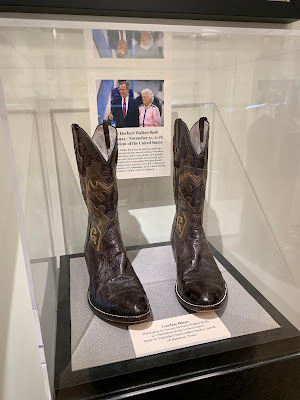If you haven't read part 1 of our day in Huntsville, you can read it HERE.
Based on Bruce's (the docent at the Sam Houston Museum) suggestion, we found our way the few miles into the town square to the Cafe Texan.
There was no doubt that the Cafe Texan is a Huntsville staple and would be reopened to continue to serve the area with familiar food but with a brand new look. The museum was always a dream just waiting to come to life, and with many years of planning and the opportunity the building presented, the dream materialized as the Cafe Texan History Museum and Library. A museum? At a cafe?
This car has a place of honor in front of the cafe
The dining room was crowded, especially since it was 2:00.
The menu has something for everybody. I had the Spinach & Pepper Gnocchi. Oh my, it was delicious!
George H.W. Bush's boots. When Vance brought them to the museum, he actually had them on as he came in the door.
One of the most interesting items was the Flintlock Pistols. These pistols were given by Emperor Napolean I to Duke Antonio Litta, the Grand Chamberlain of the Kingdom of Italy. These pistols were made in 1806 by Lepage in Paris, a French firearms manufacturer. The accessories include a mallet, hammer, tamping and cleaning rods, red morocco powder flash with metal beak, bullet mold with scalloped edge and light needle; all necessities for proper use and care of Flintlock Pistols of the era.
When Vance acquired the pistols from Sotheby's, France, in an auction, the government of France discovered that they were going to be moved to the United States. They resisted and made it extremely difficult for them to be moved. There were many obstacles to overcome but somehow, Vance was able to make it happen with the only stipulation that in the event he were ever to sell them, France insisted that they were given the right of first refusal.
Another Napolean artifact - a lock of his hair!
This 31-star American National Flag was used in the 1860 campaign of Abraham Lincoln. The stars are configured in a "double oval wreath" or "double oval medallion" on a two-piece wool bunting canton; the stripes are machine-sewn wool bunting, the canvas sleeve with brass grommets.
A stela is an upright monument containing information in the form of texts, images, or a combination of the two. These were used to commemorate people or events, to delineate physical spaces or as objects through which to access the dead or divine. This limestone stela is carved in sunk relief with the owners Inheret-Shema, "the Sole Companion, and Overseer of the Black Cattle in Shayt", and his wife "whom he loves, the Sole Ornament, Prophetess of Hathor, Set-net-Inheret", the husband holding a stave and walking stick, and wearing a leopard-skin cloak and collar, offerings placed before him, his wife wearing a long close-fitting dress, broad collar, and tripartite wig, two lines of inscription above, three columns at right.
Egyptian Polychrome Limestone Stela
1st Intermediate Period/11th Dynasty, 2180-1938 B.C.
The Pablo Picasso painted Ceramic Pitcher was made in 1952 and inscribed 'Edition Picasso' and 'Madoura' from the edition of 500. This piece is partially glazed and painted.
The Pablo Picasso Painted Ceramic Bowl with Handles was one of the many ceramic works he did, this one from 1959. It is documented to have been made in Madoura.
This rivals the necklace made out of hair that we'd seen at the Sam Houston Museum.
On display were the uniforms of Marcus Luttrell, who was depicted in the movie Lone Survivor and the only squad member who lived through the Taliban attack, and his twin brother Congressman Morgan Luttrell. Both brothers graduated from Sam Houston State University in 2000 and later became Navy Seals. I don't know why I didn't take a photo but I was able to find one online with Marcus standing next to the display.
photo courtesy of starsunfolded.com
Such interesting items but it was time to move on.
A few months before I had dropped my silver/turquoise ring and accidentally stepped on it and bent it out of shape which meant I couldn't wear it. I kept it in my purse and hoped that one day we'd run across a family jewelry store and we could ask them to straighten it for me. Today was the day!
The Museum is located in Huntsville because the first prison "The Huntsville Unit" (more informally referred to as the Walls) was built for the newly established Texas Prison System in 1848. The State of Texas Congress made a decision to create a commission to identify a location within Texas to establish its prison system. With Sam Houston's influence the Congress settled and established the town of Huntsville as the operating headquarters of the newly created prison system. Today, within the city limits of Huntsville there are five prisons and within a thirty-mile radius of Huntsville is an additional five prisons.
It felt almost ghoulish to go inside but in we went. A few interesting artifacts.
Historically, the Texas Prison System required all inmates to be clean shaven and maintain a short haircut. This practice was necessary for hygiene and security. Upon arriving into the system, a haircut was one of the first things provided. In the past few years the federal courts have ordered that male offenders accommodate their religious beliefs. Some male offenders are now allowed to grow long hair for this same reason. This is an exhibit which includes the original barber shop chairs.
It was a long day so it was time to go. We thought this shirt was humorous so we snapped a photo as we exited.
No, we didn't buy it

























No comments:
Post a Comment